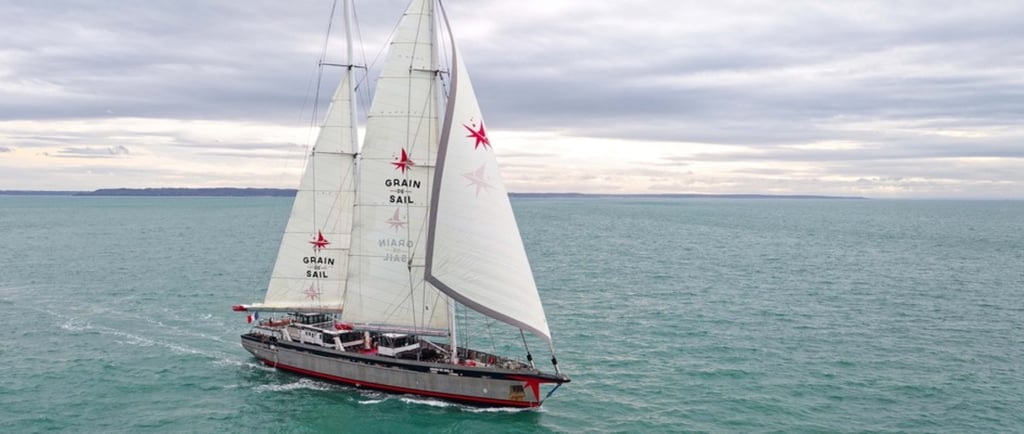Cargo facing the climate: the slow and decarbonized route of Grain de Sail
EUROPEAMERICA
7/26/20255 min read


On all the seas of the globe, giant cargo ships crisscross the horizon, invisible for most of us, but essential to our daily lives. Phones, clothing, exotic foods: almost everything we consume has traveled by boat. Yet behind this apparent fluidity of global trade lies a reality fraught with consequences: maritime transport is one of the most polluting sectors in the world, responsible for nearly 3% of global greenhouse gas emissions. Powered by some of the dirtiest fuels, it still largely escapes international climate regulations. In this context, imagining that one can cross the Atlantic without a drop of oil is almost a fairy tale. And yet, it is this crazy bet that a small Breton company, Grain de Sail, has decided to take on.
Born in Morlaix, this company combines the import of organic coffee and cocoa with the construction of modern cargo ships, capable of making transatlantic journeys relying only on the strength of the wind. Between Saint-Malo, New York and the Caribbean, it traces an unprecedented trade route, artisanal and decarbonized. This project, at the crossroads of maritime tradition and logistical innovation, intrigues as much as it inspires. He raises an essential question: can we really rethink international trade at the time of the climate emergency, not by dreaming of a distant technological future, but by reviving an energy as simple, ancient and available as the wind?
GRAIN DE SAIL: A NEW LOGISTICS MODEL AT THE SERVICE OF A DECARBONIZED TRADE
The Grain de Sail project was born from a double observation formulated by its founders, Olivier and Jacques Barreau. On the one hand, the rise of organic and fair trade generates a growing demand for products such as chocolate or coffee, whose raw materials come from Latin America. On the other hand, these foodstuffs are transported by ships running on heavy fuel oil, one of the most polluting fuels in the world. This paradox leads them to imagine logistics that are consistent with their commitments: to create a low-carbon, closed-loop maritime transport system capable of supporting real and regular commercial activity.
The Grain of Sail I, launched in 2020, is a 24-meter aluminum ship, equipped with two masts and a cargo capacity of 50 tons. It works without a thermal engine, except for port maneuvers, provided by a small electric thruster powered by solar batteries. Its first transatlantic loop—a round trip between Brittany, New York and the Caribbean — demonstrated the economic and technical feasibility of a commercial transport on a small scale. This journey is organized in three stages: the departure is from Saint-Malo with a cargo of French organic wines destined for the North American market, mainly in New York. Once the goods are delivered, the ship sets sail for the Dominican Republic, where it loads coffee and cocoa from local cooperatives. The return to Brittany allows these raw materials to be transported to the company’s processing workshops, located in Morlaix. This closed circuit ensures environmental consistency throughout the chain, while promoting a production and distribution model rooted in the territories.
A TECHNICAL REDISCOVERY OF SAILING PROPULSION
The use of sailing in contemporary freight does not mean a simple return to the past. On the contrary, it supposes a technical reinvention of navigation, based on energy optimization, lightweighting structures, meteorological precision and digital integration. Le Grain de Sail I uses traditional sails made of modern fabric, but other projects (such as Neoline) are investing in rigid or automated sails, capable of orienting according to the wind. This renewal is also based on the accurate prediction of maritime routes: thanks to weather software and routing algorithms, journeys are calculated in real time to optimize air flows and reduce navigation time.
The energy autonomy of the ship is ensured by on-board solar panels, which power the onboard electronics and safety equipment. The absence of a thermal engine over long distances implies, however, an excellent mastery of marine conditions and increased tolerance to hazards: the crossing of the Atlantic can last between 15 and 28 days, depending on the winds. Unlike conventional cargo ships that follow fixed routes, sailboats must constantly adapt their trajectory, sometimes by significantly extending their route. The main limit remains the loading capacity, too low to meet industrial volumes. That is why Grain de Sail has launched the construction of a second ship, Grain de Sail II, whose 350 tons capacity will allow a transition to a semi-industrial scale. This future vessel will measure 52 meters and include refrigerated storage spaces, which will open new perspectives for the transport of fresh products—a market where consumers' ecological expectations are particularly high.
AN ECONOMICALLY MARGINAL, BUT SYMBOLICALLY MAJOR EXPERIENCE
Economically, the Grain de Sail project cannot be compared to major global shipping companies. While a container ship can transport more than 200,000 tons of goods on a single journey, Grain de Sail I remains on an artisanal capacity of 50 tons, reserved for high value-added products. To offset the high unit cost of sailing freight, the company relies on a specific business strategy. Imported products — coffees, cocoas, chocolates—are valued as "transported cleanly", and benefit from an internal label that guarantees traceability, from planting to the port of landing. This logic makes it possible to address an audience ready to pay more for goods that are respectful of the environment and workers.
Furthermore, the project does not rely on a subsidy logic. Grain de Sail is self-sufficient, thanks to the vertical integration of its activities (transport, import, processing, sales). The company thus controls its entire value chain and limits intermediaries. This mixed and resilient business model is a rare success story in the field of low-impact logistics. But above all, beyond its economic weight, the project exerts a major symbolic influence. It attracts the interest of the media, local authorities, environmental NGOs and European institutions. By establishing itself as a proof of concept, Grain de Sail shows that sailing freight can exist outside museums, provided it is thought out as a full-fledged logistical innovation.
TOWARDS A EUROPEAN VÉLIQUE CARGO INDUSTRY?
Grain de Sail is part of a broader movement to rehabilitate wind-powered navigation. In France, companies such as TOWT (TransOceanic Wind Transport) are already experimenting with the transportation of wine, rum or olive oil on board traditional sailboats. At the same time, shipyards are developing hybrid technologies combining thermal propulsion and sail assistance, such as automated rigid sails or kite wings (giant kites) tested by Airseas, a start-up supported by Airbus.
At the European level, the European Commission finances research projects within the framework of the Horizon Europe programme, aimed at creating a low-carbon maritime transport sector by 2050. Sail propulsion is now among the strategic options considered in the Green Deal, alongside alternative fuels (green ammonia, e-methanol, liquefied hydrogen). Although sailing will never be able to meet all the needs of global trade, it can nevertheless fit into a differentiated logistics ecosystem: small volumes, short circuits, fragile or valued foodstuffs, island or coastal markets. In this sense, Grain de Sail embodies not a single solution, but a component of a plural maritime future, slower, more sober, but also more human.
Thomas Dos Remedios, for SPECTIO
The statements made are solely those of their authors and do not reflect the position of the Think Tank Spectio.
